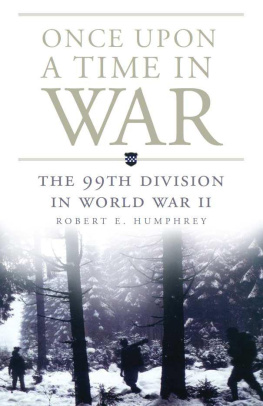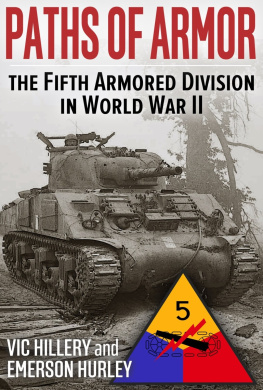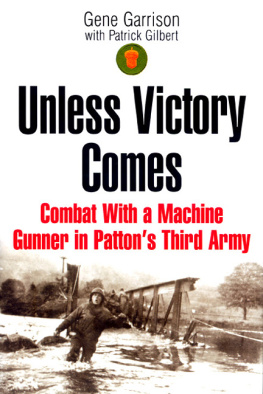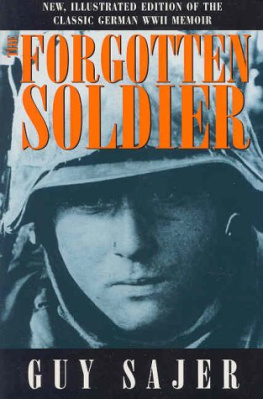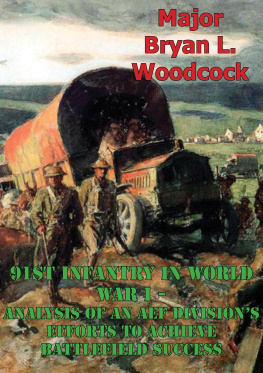Once Upon a Time in War

Campaigns and Commanders
GENERAL EDITOR
Gregory J. W. Urwin, Temple University, Philadelphia, Pennsylvania
ADVISORY BOARD
Lawrence E. Babits, East Carolina University, Greenville
James C. Bradford, Texas A&M University, College Station
Robert M. Epstein, U.S. Army School of Advanced Military Studies, Fort Leavenworth, Kansas
David M. Glantz, Carlisle, Pennsylvania
Jerome A. Greene, Denver, Colorado
Victor Davis Hanson, California State University, Fresno
Herman Hattaway, University of Missouri, Kansas City
John A. Houlding, Rckersdorf, Germany
Eugenia C. Kiesling, U.S. Military Academy, West Point, New York
Timothy K. Nenninger, National Archives, Washington, D.C.
Bruce Vandervort, Virginia Military Institute, Lexington
Once Upon a Time in War
THE 99TH DIVISION IN WORLD WAR II
Robert E. Humphrey
UNIVERSITY OF OKLAHOMA PRESS : NORMAN

2800 Venture Drive
Norman, Oklahoma 73069
www.oupress.com
Copyright 2008 by the University of Oklahoma Press, Norman, Publishing
Division of the University.
All rights reserved. No part of this publication may be reproduced, stored in a retrieval system, or transmitted, in any form or by any means, electronic, mechanical, photocopying, recording, or otherwiseexcept as permitted under Section 107 or 108 of the United States Copyright Act without the prior permission of the University of Oklahoma Press.
For information about permission to reproduce selections from this book, write to Permissions, University of Oklahoma Press, 2800 Venture Drive, Norman, Oklahoma 73069 or email rights.
ISBN 978-0-8061-8357-2 (eBook-mobipocket)
ISBN 978-0-8061-8358-9 (eBook-epub)
Once Upon a Time in War: The 99th Division in World War II is Volume 18 in the Campaigns and Commanders series.
This eBook was converted from the original source file by a third-party vendor. Readers who notice any formatting, textual, or readability issues are encouraged to contact the publisher at .
To all those who served in the 99th Infantry Division
I love the infantry because they are the underdogs. They are the mud-rain-frost-and-wind boys. They have no comforts, and they even learn to live without the necessities. And in the end they are the guys that wars cant be won without.
Ernie Pyle, World War II correspondent, May 1, 1943
Contents
Illustrations
FIGURES
MAPS
Preface
War came suddenly and violently to the United States in 1941. Inadequately prepared for a global conflict, the government needed to build up a huge military force quickly to combat formidable enemies who represented a serious military and political threat. Eventually the army created eighty-seven active divisions (forty-two served in Northern Europe). The 99th became one of the many new infantry divisions that comprised the emergency army of the United States, distinguishing it from the small number of regular army divisions and eighteen National Guard divisions. Also called the Checkerboard Division, with its identifying left shoulder patch of blue and white squares superimposed on a five-sided black shield, the 99th came into existence in November 1942.
At full strength of 14,208 men, the 99th Infantry Division followed the World War II triangular organization of three infantry regiments, in this case the 393rd, the 394th, and the 395th. The regiments were divided into three battalions (first, second, and third) with 860 men in each and subdivided into four companies identified by letters of the alphabet running consecutively. Thus the 1st battalion contained A, B, and C rifle companies (each consisting of 187 enlisted men) and D, a heavy weapons company, 166 men, with eight .30-caliber water-cooled machine guns and six 81mm mortars. The second battalion consisted of E, F, and G rifle companies, and H, the heavy weapons company; the third battalion included I, K, and L rifle companies and M, the heavy weapons company. The alphabet letters stood for radio code names: Able, Baker, Charlie, Dog, Easy, Fox, George, How, Item, King, Love, and Mike. In addition, a cannon company for each regiment could fire six 105mm howitzers, two rocket launchers, and three .50-caliber machine guns.
A rifle company had three rifle platoons and one weapons platoon. Each rifle platoon consisted of forty-one men, while the weapons platoon had an officer, a platoon sergeant, and thirty-three enlisted men. The weapons platoon contained two squads of light machine guns (.30-caliber, air-cooled) and three squads of 60mm mortars. Finally, each rifle platoon was made up of three twelve-man squads; in each squad eleven men carried a .30-caliber, semi-automatic M-1 Garand rifle (weighing 9 lb., 5 oz.), and one soldier lugged the 22-lb. fully automatic Browning Automatic Rifle (BAR). While no one fighting in the division could be assured of complete safety, those 3,240 GIs in the twenty-seven rifle companies served offensively as the spear tip and defensively as the shield; therefore, they suffered the highest casualties.
The 99th Division first assembled and trained at Camp Van Dorn in southwestern Mississippi. Following combat maneuvers in Mississippi and Louisiana, the division relocated to a training facility at Camp Maxey in northeastern Texas. When the army transferred three thousand enlisted men from the 99th to the 85th and 88th Infantry Divisions, replacements came from the Army Specialized Training Program (ASTP), which had placed bright GIs in colleges and universities to produce engineers, doctors, dentists, and language specialists. Disappointed and unhappy about the programs cancellation, ASTPers lost an opportunity to complete a free college education; worse yet they became privates in an infantry division. Most thought their abilities and skills could be better utilized than as cannon fodder.
After weeks of basic and advanced infantry training, the 99th Division left Camp Maxey for the Port of Embarkation, Boston Harbor, departing on September 29, 1944, for Great Britain and, ultimately, the Continent. In early November they rode in trucks from the destroyed harbor of Le Havre, France, to forested front lines in the Ardennes (Belgium), at the time a quiet sector where wintry weather conditions and difficult terrain would, it was thought, guarantee limited combat. For a month this prognostication proved accurate, and some believed the war would end by Christmas.
Everything changed on December 16, 1944, when the Wehrmacht launched a massive counterattack that came to be known as the Battle of the Bulge, the largest battle involving American forces in World War II. Greatly outnumbered with limited tank and fighter support, many companies of the 99th incurred serious losses. After putting up a stout fight, they withdrew to the high, barren ground of Elsenborn Ridge and established defensive lines that stopped elements of the German Army from breaking through in their sector. During the six weeks that followed, infantry soldiers of the 99th endured three infantry attacks, artillery bombardment, sniper fire, and unrelenting cold and snow without stoves, adequate clothing, or warm, waterproof boots.
At the end of January 1945, the 99th became engaged in mopping-up operations over territory lost during the battle. After a brief respite behind the lines, the division moved across the Cologne Plain, reaching the Rhine River near Dsseldorf in early March 1945. Almost immediately the 99th rushed southward after the capture of the Ludendorff Bridge, crossed the Rhine at Remagen, and advanced east and then north, where they participated in the encirclement and capture of German forces in the Ruhr pocket. With barely a days rest, 99ers piled onto trucks and joined George Pattons Third Army near Bamberg. From there they proceeded past Nuremberg and advanced to the Danube River, which the troops crossed on the 27th of April. A few days later, on May 8, 1945, the war came to an official end, six months after the divisions initial combat, and the victorious Checkerboarders relocated to northern Bavaria and settled into postwar occupation of Germany. They accomplished their mission at a cost of 1,134 killed, 3,954 wounded, and 6,103 nonbattle casualties.2

